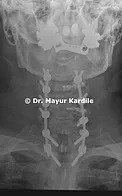 Book Appointment
Book Appointment
 +91 77740 40002
+91 77740 40002
The procedure pf Posterior Cervical Instrumentation and Fusion Treatment which uses spinal fusion technique may be recommended when the spine is unstable or the natural disc space has decreased. The technique is used for stabilizing the spinal bones or vertebrae. The goal of lumbar fusion is to create a firm bridge of bone between two or more vertebrae. In such cases the cervical spine needs to be fixed with screws, rods and bone graft to achieve fusion. This can be done with a wide variety of implants like Lateral Mass Screws, Pedicle screws, Translaminar screws, Occipito-Cervical Plate.
The use of individual implants depends on the disease-specific condition of the patient Cervical Laminoplasty and Lateral Mass Fusion. This is the best surgery for posterior cervical fusion and decompression. The goal of this procedure is to decrease pain, correct spinal deformity and improve stability.
This Posterior Cervical Instrumentation and Fusion Treatment Procedure is performed under general anesthesia. While the surgery is going on the patient lies with face down on a specialized surgical bed. Surgeon makes a small incision on the back to approach the spine. Then, surgeon fuses the posterior elements of the spine. This can be an approach to remove a damaged disc or to relieve pressure on the nerves of the spinal canal. Fusion is accomplished by instruments such as pedicle screws, rods and using bone graft. This is done to accomplish fusion, in a staged surgery.

Posterior Cervical Instrumentation and Fusion Treatment is often the second part of a staged surgery. In these cases, the posterior instrumentation may be required for further decompression and stabilization after an interbody fusion, may be necessary in case of osteoporosis when bones do not have optimal strength and the bones may not be strong enough to hold a fusion together while new bone grows. In case of patients with severe spinal stenosis may require a more extensive decompression to free up severely narrowed nerve space.
In the Posterior Cervical Instrumentation and Fusion treatment, the postoperative pain control is achieved with the use epidural pain medication, IV pain medication, and oral pain medications. Patient requires a catheter for one or two days after surgery. Physical therapist works with the patient to train for getting out of bed, walking safely and climbing stairs. Gastrointestinal and urinary system working is ensured prior to discharge from the hospital. Patient is on oral pain medication on discharge from the hospital.